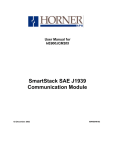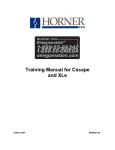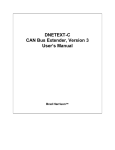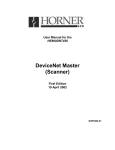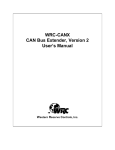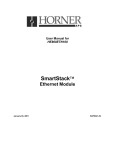Download User Manual for HE800JCM200
Transcript
User Manual for
HE800JCM200
SmartStack SAE J1939
Communication Module
14 May 2002
MAN0484-01
PREFACE
14 MAY 2002
PAGE 3
MAN0484-01
PREFACE
This manual explains how to use SmartStack SAE J1939 Communication Modules.
Copyright (C) 2002 Horner APG, LLC., 640 North Sherman Drive Indianapolis, Indiana 46201. All rights
reserved. No part of this publication may be reproduced, transmitted, transcribed, stored in a retrieval
system, or translated into any language or computer language, in any form by any means, electronic,
mechanical, magnetic, optical, chemical, manual or otherwise, without the prior agreement and written
permission of Horner APG, Inc.
All software described in this document or media is also copyrighted material subject to the terms and
conditions of the Horner Software License Agreement.
Information in this document is subject to change without notice and does not represent a commitment on
the part of Horner APG.
SmartStack is a trademark of Horner APG.
For user manual updates, contact Horner APG Technical Support
Division, at (317) 916-4274 or visit our website at www.heapg.com.
PAGE 4
MAN0484-01
14 MAY 2002
PREFACE
LIMITED WARRANTY AND LIMITATION OF LIABILITY
Horner APG,LLC. ("HE-APG") warrants to the original purchaser that the SmartStack SAE J1939 Communication
Module manufactured by HE-APG is free from defects in material and workmanship under normal use and service.
The obligation of HE-APG under this warranty shall be limited to the repair or exchange of any part or parts which
may prove defective under normal use and service within two (2) years from the date of manufacture or eighteen (18)
months from the date of installation by the original purchaser whichever occurs first, such defect to be disclosed to
the satisfaction of HE-APG after examination by HE-APG of the allegedly defective part or parts. THIS WARRANTY
IS EXPRESSLY IN LIEU OF ALL OTHER WARRANTIES EXPRESSED OR IMPLIED INCLUDING THE
WARRANTIES OF MERCHANTABILITY AND FITNESS FOR USE AND OF ALL OTHER OBLIGATIONS OR
LIABILITIES AND HE-APG NEITHER ASSUMES, NOR AUTHORIZES ANY OTHER PERSON TO ASSUME FOR
HE-APG, ANY OTHER LIABILITY IN CONNECTION WITH THE SALE OF THIS SmartStack SAE J1939
Communication Module. THIS WARRANTY SHALL NOT APPLY TO THIS SmartStack SAE J1939 Communication
Module OR ANY PART THEREOF WHICH HAS BEEN SUBJECT TO ACCIDENT, NEGLIGENCE, ALTERATION,
ABUSE, OR MISUSE. HE-APG MAKES NO WARRANTY WHATSOEVER IN RESPECT TO ACCESSORIES OR
PARTS NOT SUPPLIED BY HE-APG. THE TERM "ORIGINAL PURCHASER", AS USED IN THIS WARRANTY,
SHALL BE DEEMED TO MEAN THAT PERSON FOR WHOM THE SmartStack SAE J1939 Communication Module
IS ORIGINALLY INSTALLED. THIS WARRANTY SHALL APPLY ONLY WITHIN THE BOUNDARIES OF THE
CONTINENTAL UNITED STATES.
In no event, whether as a result of breach of contract, warranty, tort (including negligence) or otherwise, shall HEAPG or its suppliers be liable of any special, consequential, incidental or penal damages including, but not limited to,
loss of profit or revenues, loss of use of the products or any associated equipment, damage to associated equipment,
cost of capital, cost of substitute products, facilities, services or replacement power, down time costs, or claims of
original purchaser's customers for such damages.
To obtain warranty service, return the product to your distributor with a description of the problem, proof of
purchase, post paid, insured and in a suitable package.
ABOUT PROGRAMMING EXAMPLES
Any example programs and program segments in this manual or provided on accompanying diskettes are included
solely for illustrative purposes. Due to the many variables and requirements associated with any particular
installation, Horner APG cannot assume responsibility or liability for actual use based on the examples and diagrams.
It is the sole responsibility of the system designer utilizing the SmartStack SAE J1939 Communication Module to
appropriately design the end system, to appropriately integrate the SmartStack SAE J1939 Communication Module
and to make safety provisions for the end equipment as is usual and customary in industrial applications as defined in
any codes or standards which apply.
Note: The programming examples shown in this manual are for illustrative
purposes only. Proper machine operation is the sole responsibility of the
system integrator.
PREFACE
14 MAY 2002
PAGE 5
MAN0484-01
Table of Contents
CHAPTER 1: INTRODUCTION........................................................................................................... 7
1.1
Overview ..............................................................................................................................7
1.2
Product Description ...............................................................................................................7
1.3
Functional Description ...........................................................................................................7
1.4
Technical Support .................................................................................................................8
CHAPTER 2: OPERATION ................................................................................................................ 9
2.1
General.................................................................................................................................9
2.2
Two Communication Methods for Handling Data .....................................................................9
2.3
Scanning ..............................................................................................................................9
2.4
Transmit Channel ................................................................................................................ 10
2.4.1
Transmit Channel Register Definitions ........................................................................... 10
2.4.2
Transmit Channel Operation Overview........................................................................... 11
2.4.3
Send Data.................................................................................................................... 11
2.4.4
Low Priority Request..................................................................................................... 12
CHAPTER 3: CONFIGURATION ...................................................................................................... 13
3.1
General............................................................................................................................... 13
3.2
Configuration....................................................................................................................... 13
PAGE 6
MAN0484-01
14 MAY 2002
PREFACE
CH. 1
14 MAY 2002
PAGE 7
MAN0484-01
CHAPTER 1: INTRODUCTION
1.1
Overview
The HE800JCM200 is a SmartStack SAE J1939 Communication Module. SAE J1939 (J1939) is a CANbased protocol used in truck and bus control communications networks. There are various layers to the
J1939 protocol that are described in SAE J1939 documents. J1939 uses a 29-bit identifier requiring
hardware that can support CAN 2.0B. The address for the JCM200 is fixed at 251. The baud rate is fixed
at 250Kbps. SAE J1939 specifies a table of Parameter Group Numbers (PGNs). A PGN is unique
numeric identifier that is associated with a specific parameter name. A PGN is used to define the
parameter value a device is requesting or the parameter value that a device is sending.
Note: SAE is an acronym for Society of Automotive Engineers.
1.2
Product Description
There are 2 operational bi-colored LEDs on the side of the module. One LED is green indicating the
module is OK. The other LED flashes orange, indicating network traffic.
1.3
Functional Description
The JCM200 can request/monitor data from and transmit data to devices on the J1939 network. There
are two communication methods used for handling data: Scanning and Transmit Channel. For detailed
information, refer to Chapter 2: Operation.
PAGE 8
MAN0484-01
1.4
14 MAY 2002
Technical Support
For assistance, contact Technical Support at the following locations:
North America:
(317) 916-4274 or visit our web site at www.heapg.com.
Europe:
(+) 353-21-4321-266
CH.1
CH. 2
14 MAY 2002
PAGE 9
MAN0484-01
CHAPTER 2: OPERATION
2.1
General
Chapter Two covers operational information for the JCM200.
2.2
Two Communication Methods for Handling Data
The JCM200 can request and monitor data from and transmit data to devices on the J1939 network.
There are two communication methods used for handling data. The first method is Scanning in which
Parameter Group Numbers (PGNs) are pre-configured, and the module continuously gathers data for the
configured PGNs. The second method is a Transmit Channel in which a message is built in PLC
registers and is transmitted onto the network. The following sections cover each communication method
in detail.
2.3
Scanning
The Scanning method uses a scan table that contains a series of PGNs and associated information.
Data for the configured PGNs is continuously gathered and sent to the PLC. There are two modes for
gathering data from devices on the J1939 network, monitor and request. Each PGN in the scan table is
configured to use one of the two modes for gathering data. The JCM200 does not know which PGNs
require monitoring and which PGNs require requesting; it is the responsibility of the individual configuring
the module to enter the information. Otherwise, the data may not be updated.
a.
Monitor Mode
An engine control module (ECM) sends some PGN data onto the network at regular intervals. The
specific PGNs that are sent vary between ECMs. If the ECM broadcasts a desired PGN’s data on a
regular basis, then the mode for that PGN is configured for monitor.
Monitoring does not require interaction between the JCM200 and a device on the network. The JCM200
monitors the network for the PGNs that are configured as monitor mode in the scan table. If it finds a
match, then the data is sent to the PLC.
b.
Request Mode
If the desired PGN is not sent on a regular basis, then a request must be made from the JCM200 to the
device before the data is sent. The mode for these PGNs are configured for request.
Requesting requires interaction between the JCM200 and a device on the network. The JCM200 must
send a request message to a device onto the network and receive a reply before that data can be sent to
the PLC.
PAGE 10
MAN0484-01
2.4
14 MAY 2002
CH. 2
Transmit Channel
The Transmit Channel can be used one of two ways. It can be used to send data to a device on the
network or it can be used as low priority request to retrieve data from a device on the network.
The complete Transmit Channel uses 11 %AQs, 2 %Qs and 2 %Is. The %AQs and %AIs vary depending
on whether a send data or request data type of communication is used.
2.4.1
Transmit Channel Register Definitions
The following are the registers used by the Transmit Channel and the corresponding descriptions. Not all
registers are used for both types of communications.
Table 2.1 - %AQ Definitions for Transmit Channel
Description
%AQ Register
PGN
AQx
Destination Address (255 – Global)
AQx+1
Number of bytes (Up to 8)
AQx+2
Starting %R register/ Byte value 1
AQx+3
Byte value 2
AQx+4
Byte value 3
AQx+5
Byte value 4
AQx+6
Byte value 5
AQx+7
Byte value 6
AQx+8
Byte value 7
AQx+9
Byte value 8
AQx+10
Table 2.2 - %R Definitions for Transmit Channel
Description (High/Low byte)
%R Register
Requested PGN
Rx
Request data value byte 1
Rx+1
Request data value byte 2
Rx+2
Request data value byte 3
Rx+3
Request data value byte 4
Rx+4
Request data value byte 5
Rx+5
Request data value byte 6
Rx+6
Request data value byte 7
Rx+7
Request data value byte 8
Rx+8
CH. 2
14 MAY 2002
PAGE 11
MAN0484-01
Table 2.3 - %Q Definitions for Transmit Channel
Description
%Q Register
Transmit
Command
Qx
Type
of
Transmit
(0 for send data)
Qx+1
Table 2.4 - %I Definitions for Transmit Channel
Description
%I Register
Transmit
Complete
Ix
Transmit
Error
Ix+1
Bus
Off
Error
Ix+2
Power Fail Error
Ix+3
2.4.2
Transmit Channel Operation Overview
The %AQs contain the information to be transmitted, the %Rs contain data from the device, the %Qs are
used to control when and what to transmit, and the %Is report the status. Toggling %Qx from 0 to 1
triggers the JCM200 to send the data. The value of %Qx+1 determines the type of transmit, where 0
equals send data and 1 equals low priority request. The %AQ usage changes depending on the value of
%Qx+1.
%Ix goes to 1 when the transmit operation completes, thus notifying the PLC that another transmit can
occur. %Ix+1 indicates whether or not a transmit error occurred, where 0 equals OK and 1 equals an
error.
Toggling %Qx from 1 to 0 clears the %Ix and %Ix+1 in order to setup for another transmit.
The following sections describe the how the %AQ and %AI registers are used.
2.4.3
Send Data
When the transmit channel is used to send data to a device on the network then the 11 %AQs, 2 %Qs
and 2 %Is are used.
Send Data Register Use:
The %AQs contain the information to be transmitted. The %AQs need to be loaded with the appropriate
data before %Qx is toggled from a 0 to 1 to initiate the transmit.
The following is a detailed description of the %AQ data:
%AQx contains the PGN where the associated data will be written
%AQx+1 contains the destination address of the device that the data is being sent to
%AQx+2 contains the number of bytes of data to be sent, up to 8 bytes.
%AQx+3 - %AQx+10 contains the data to be sent. Note that %AQs are word values but the data should
only be a byte value. The upper byte of the word should be 0. Received values are packed into word
values (low byte and high byte are separate returned values). The bytes for the transmit channel are
separated for ease of configuration and use.
PAGE 12
MAN0484-01
2.4.4
14 MAY 2002
CH. 2
Low Priority Request
When the transmit channel is used to a low priority request to a device on the network then the first 4
%AQs, 2 %Qs, 2 %Is, and a defined number of %Rs are used.
Low Priority Request Register Use:
The %AQs contain the information to be transmitted. The %AQs need to be loaded with the appropriate
data before %Qx is toggled from a 0 to 1 to initiate the transmit. The %Rs will contain the request data if
%Ix+1 is not set (No transmit error).
The following is a detailed description of the %AQ and %AI data:
%AQx contains the PGN that is being requested.
%AQx+1 contains the destination address of the device that contains the requested data.
%AQx+2 contains 2 bytes for the requested PGN and the number of bytes of requested data to store in
the %R registers [CURRENTLY FIXED AT A MAX OF 10 BYTES (2 for PGN + 8 for data].
%AQx+3 contains the starting %R register where the requested data will be stored.
The remaining %AQs are not used.
%Rx contains the requesed PGN that is associated with the following data
%Rx+1 contains data byte 1
%Rx+2 contains data byte 2
%Rx+3 contains data byte 3
%Rx+4 contains data byte 4
%Rx+5 contains data byte 5
%Rx+6 contains data byte 6
%Rx+7 contains data byte 7
%Rx+8 contains data byte 8
CH. 3
14 MAY 2002
PAGE 13
MAN0484-01
CHAPTER 3: CONFIGURATION
3.1
General
Chapter Three covers the configuration of the JCM200. The purpose of the configuration is to allow
communication between an OCS/RCS and an Engine Control Module.
Note: To perform this configuration, it is necessary to consult the engine manufacturer’s user
documentation to determine parameter numbers and the corresponding number of words
for each parameter.
3.2
Configuration
a. First, invoke Cscape. From the Cscape Main Menu, select Controller | I/O Configure… .
Ensure the correct
controller is
selected. To change
controllers, press
CPU Slots and
select the desired
module.
You can add an I/O
module to any slot,
but Slot 1 must not
be empty.
Figure 3.1 – Select the Module Slot
Ensure that the desired controller is selected. The OCS300-CsCAN is shown as the selected controller
(Fig. 3.1) in this example. If satisfied with the controller selection, press a Base # tab, and go to Step 3.
If a different controller is desired (as it is in this configuration example), continue Step 2.
Note: The Auto Config System button can be pressed prior to selecting the desired controller and I/O.
By pressing the button, the settings are deleted from any controller and I/O that is physically connected to
the PC. A dialog box appears and indicates that settings will be deleted from currently configured
models. If OK, press Yes. Then press OK.
PAGE 14
MAN0484-01
14 MAY 2002
CH. 3
Figure 3.2 – Select the Comm tab
b. Next, double-click on the empty slot in which the JCM200 module will reside, or click on the Config
button to the right of the slot position. This invokes the Add I/O Module screen. Click on the Comm tab.
From that dialog, select the JCM200 module, and click OK.
Figure 3.3 – JCM200 Module is Added
c. The screen returns to the Configure I/O dialog box - with the selected slot showing that the JCM200
module has been added.
Double-click on the JCM200 module in the I/O configuration screen (Figure 3.3) or click on the Config
button next to the JCM200 module.
CH. 3
14 MAY 2002
PAGE 15
MAN0484-01
d. The following screen appears: Two tabs are available for selection:
Figure 3.4 – Module Configuration
I/O Map Tab
NOTE:
Ignore this screen at this point. %AI registers can be varied during configuration; they are not
fixed. As a result, a more complete I/O Map is provided later on in the configuration process
after adding and deleting %AI as required.
Module Setup Tab
The Module Setup screen has two important functions.
Figure 3.5 – Module Setup Tab
Function 1: Pressing the Module Setup tab displays a screen with a Configure button.
Pressing the Configure button opens the following Configurator screen.
Function 2:
After you finish with the Configurator, be sure to return to this screen and
press OK (or CANCEL) to save (or cancel) all changes..
PAGE 16
MAN0484-01
14 MAY 2002
CH. 3
e. The following screen appears.
Standard Configuration
focuses on 3 register types:
%Q, %AQ, %I. These types
have a fixed number of
registers.
This screen is used to
map the OCS %AI
registers that contain
parameter values from
Engine Control Modules.
Scan Setup
focuses on %AI register
configuration. The
ending register location
and number of registers
for %AIs varies
depending on the register
map.
This portion of the
screen is used to create
a %AI register map to
depict %AI registers that
have been added.
If you want to add a %AI
register, enter a Starting
%AI Register number.
Then, press Add.
To Delete a %AI register,
double-click the item, and
a screen appears
allowing you to delete the
register.
%AIs listed here can be
double-clicked to delete /
edit them.
Figure 3.6 - JCM200 Configuration Program
Standard Configuration
The JCM200 has a fixed number of 8 %Qs, 8 %Is, and 11 %AQs.
Type: Displays the register types assigned to the module.
Starting Register: Denotes the starting location of the register type. These are user-editable fields.
Ending Register: Denotes the ending location of the register type. These fields are automatically
updated by the Configurator.
Number: Indicates the quantity of a particular register type. These fields are automatically updated by
the Configurator.
CH. 3
14 MAY 2002
PAGE 17
MAN0484-01
Scan Setup Configuration
Scan Setup Configuration Overview:
A single PGN can contain multiple bytes of parameter information. That information needs to be defined
for each PGN in order for the JCM to understand what PGN data is to be stored into the corresponding
%AIs. The PGN Configuration screen allows for entering the required information to create a data map
between PGN data value and %AI registers.
The Scan Setup Configuration depicts the Type, Starting Register, Ending Register, and Number of
Registers for the %AI registers. (See Standard Configuration for an explanation of these parameters.)
The Scan Setup Configuration is used to configure %AI registers. (The number of %AIs vary depending
on your Scan Table configuration.)
To add a %AI, enter a Starting Register number. Press the Add button.
The following screen appears.
To configure, enter the
PGN and Number of
Words expected by the
Engine Control Module.
These boxes are
automatically updated
by the Configurator.
Scan Method:
Select Monitor method
or Request method.
Figure 3.7 - PGN Configuration
%AI: Denotes the %AI register being configured (or deleted). This box is automatically updated by the
Configurator.
PGN : In order for the OCS/RCS to communicate with an Engine Control Module, it is necessary to
consult the engine manufacturer’s user documentation to determine Parameter Group Numbers (PGN)
and the definition for the words for each parameter.
SAE J1939 specifies a table of PGNs. A PGN is unique numeric identifier that is associated with a
specific parameter name. A PGN is used to define the parameter value(s) a device is requesting or the
parameter value(s) that a device is sending. (Requires a number to be entered between 0 through
65,536.)
PAGE 18
MAN0484-01
14 MAY 2002
CH. 3
Number of Words: This value represents the number of words from the PGN data to store into %AIs. A
PGN could contain 8 words of data. If only the first 4 words are needed then this value would be set to 4.
(Requires a number to be entered between 1 - 50.)
Starting Word: This value represents an index into the PGN data. Currently, this value is fixed a 1 so
the PGN data starting at word 1 through the Number of Words will stored to %AIs. If the desired PGN
data word is at word 6 then Number of Words would set at 6 (PGN data word 1 – data word 6 would be
stored to %AIs).
In the future, this value may be adjustable, which would allow for starting at PGN data word 2 or higher.
f. Scan Method: The Scanning method uses a scan table that contains a series of PGNs and
associated information. Data for the configured PGNs is continuously gathered and sent to the PLC.
There are two modes for gathering data from devices on the J1939 network, monitor and request. Each
PGN in the scan table is configured to use one of the two modes for gathering data. It denotes the
method used to scan and obtain PGN values.
Monitor Mode
If the Engine Control Module broadcasts a desired PGN’s data on a regular basis, then the mode
for that PGN is configured for monitor.
Monitoring does not require interaction between the JCM200 and a device on the network. The
JCM200 monitors the network for the PGNs that are configured as monitor mode in the scan
table. If it finds a match, then the data is sent to the PLC.
Request Mode
If the desired PGN is not sent on a regular basis, then a request must be made from the JCM200
to the device before the data is sent. The mode for these PGNs are configured for request.
Requesting requires interaction between the JCM200 and a device on the network. The JCM200
must send a request message to a device onto the network and receive a reply before that data
can be sent to the PLC.
CH. 3
14 MAY 2002
PAGE 19
MAN0484-01
g. During the configuration, it is possible that the following screen appears. In the event that it does
appear, press the HE800JCM200 Configurator button (located on the Menu bar at the very bottom of the
screen) to return to the configuration screen. This screen simply prompts you to close the JCM200 editor
to continue.
Figure 3.8 - PGN Configuration
h. Here is an example configuration screen.
Press here
after making
the register
map.
Figure 3.8 – Example Configuration
Then save
your changes
on the screen
that follows.
Figure 3.9 – Example Configuration
i. After making the register map, you need to save the configuration changes by exiting the configuration
screen and then returning to the Module Setup screen.
PAGE 20
MAN0484-01
14 MAY 2002
Figure 3.10 – Module Setup Tab
j. To save or cancel your settings, be sure to return to this screen and press OK or CANCEL.
CH. 3




















